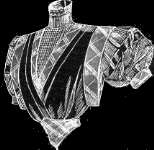| INDEX | 1300-1599 | 1600s | 1700s | 1800s | 1900s | CROSS-ERA | ETHNO | |
| MISCELLANY | CONTACT | SEARCH | |

A taille and a skirt make a decent dress. Since about 1892 no simple and straightforward
taille has been seen anymore: There were either very carefully formed tailor's
tailles or over-draped blouse tailles. In the early 20th century, a new form
emerged: The loose blouse. The patterns on the Early
20th Century page represent the basic pattern that was traditional by then,
i.e. it can be used as a basic pattern for any taille from about 1880 until
1910, provided that you see for the historically correct corset shape and garniture
yourself.
As a taille has to fit very closely, a lot of trying on and adjustment is needed. Never expect a default pattern to fit.
This is certainly nothing for a sewing novice. Well, actually none of the historical dresses is. *g*
The lining (of taffeta) is done first, tried on and adjusted until it really fits. The adjustments can then be applied to the cut employed for the upper cloth, which is only loosely connected with the lining, similar to a suit jacket today.
A look a the picture of the inside of a half-finished simple and tight-fitting taille will tell an experienced semstress most anything there is to know, i.e.:
It is closed with hooks and eyes which in 1908 were available as ready-made
strips that just had to be sewn on. An additional strip of upper cloth is
sewn onto the side where the hooks are (normally right). All the seams, including
the front edges, get whalebone stiffening, inserted into a hose of cloth and
secured with a fan-shaped "fly" at both ends and
crisscrossing thick thread down its length. It is sewn in very tightly, i.e.
a bit shorter than the seam it is sewn onto.
The lower end of the whalebone has to be ~1 cm above the hem. The hem is cleaned
up with a strip of in diagonal grain (preferably silk). The shoulder seams are
done last, and it's advisable to try it on just before doing that. Don't forget
to apply a waistband as the finish. For good fit,
it has to be a few millimetres above the actual waistline.
The bodices of ball dresses were cut from basically
the same pattern and made the same way as tailles, only sleeves and décolleté
were different. See pattern. As for blouse
tailles, which were worn from the late 1800s (see pic)
the lining is done the same way as the upper cloth of the taille: same pattern,
and whalebone stiffening. Onto that the upper cloth is draped. Tailors did
a lot of fantascic things with folds, lace, embroidery and whatnot. If you don't
need an historically correct blouse taille, give your imagination some excercise!
Some examples: step1, step2,
step3 of draping a blouse taille, waistcoat-style
garniture.
As the hem of a blouse taille wasn't visible it wasn't given too much care. Tailles that are
to be worn on top of the skirt get a belt sewn onto the hem. In this case the front of the
upper cloth must be shorter than the lining, otherwise it would add volume to the waist.
Blouses
basic pattern: simple blouse
Blouses had first appeared at the time of the French Revolution and on and off from then on, but had never played much of a role until the 1890s, when they became presentable. From around the turn of the century they became an important part of a lady's wardrobe. They were worn at home, in the office (yes, office!), for walks or visits or sport, and even to the theatre or concerts. Its versatility and the fact that it was not stiffened secured its success. The only thing that really requires a taille is formal wear.
Still, blouses were not as loose and comfy as they look: They were lined with the lining modeled on the taille pattern, i.e. tight-fitting. Only the upper cloth is loose. In that, and in the making, it is similar to the blouse taille. The upper cloth is sewn onto the lining. If the blouse hs a yoke, the upper edge is fixed on the lining along the line that marks the lower end of the yoke, and the yoke sewn onto that later. Like a blouse taille, a blouse can end in a little tail or a sewn-on belt. Around 1908, it was fashionable to make the blouse longer, stuff it under the skirt, put a belt over it, and pull the upper cloth, esp. the front, out a little so that it bagged ove the waistline. (see picture) For better fit, a waistband is sewn into the back and tied in front.
Shirt blouses, which are used for home and household chores and thus have to be washed often, are not lined and usually buttoned (while for other blouses and tailles hooks or patent buttons were preferred). The standing collar is buttoned on.
The making of sleeves and standing collars deserves an extra page.
Content, layout and images of this page
and any sub-page of the domains marquise.de, contouche.de, lumieres.de, manteau.de and costumebase.org are copyright (c) 1997-2022 by Alexa Bender. All rights reserved. See Copyright Page. GDPO
This work is licensed under a Creative Commons License.